

Réflexions sur la remédiation. Commençons la nouvelle année civile par un petit topo sur la remédiation, qui, comme chacun le sait, est une des – nombreuses – priorités du gouvernement Olivier.
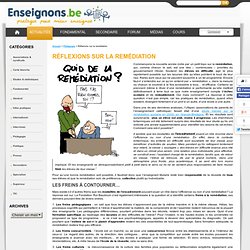
Soutenir les élèves en difficulté, agir le plus rapidement possible sur les lacunes dès qu’elles pointent le bout de leur nez. Rares sont ceux qui ne peuvent souscrire à un tel programme. How to teach … behaviour management. The ability to manage the behaviour of your class effectively is one of the top skills that every teacher needs.

Even the most meticulously planned lessons can go to pot if students misbehave. Many practitioners, including newly-qualified teachers, are always on the lookout useful class management techniques especially before the new school year begins, so we've collected a range of useful resources to help you get the best out of your pupils.
In Positive ways to manage behaviour, Paul Dix provides a range of techniques for getting your class under control, including: establishing explicit rules and routines, providing students with clear choices around their behaviour, and letting them start each day with a clean sheet. Further advice on some of the most common behaviour problems can be found in Classroom management strategies. Handling Difficult Students The First Week Of School. Hoping to head misbehavior off before it starts, most teachers try to be proactive with difficult students.
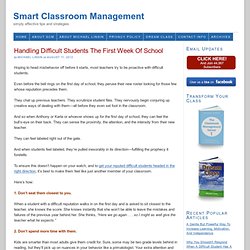
Even before the bell rings on the first day of school, they peruse their new roster looking for those few whose reputation precedes them. They chat up previous teachers. They scrutinize student files. A Classroom Management Strategy For The First Days Of School. At the start of a new school year, it’s common for teachers to send home a packet of information for parents.
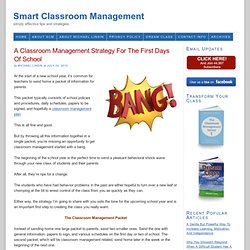
This packet typically consists of school policies and procedures, daily schedules, papers to be signed, and hopefully a classroom management plan. This is all fine and good. But by throwing all this information together in a single packet, you’re missing an opportunity to get classroom management started with a bang. The beginning of the school year is the perfect time to send a pleasant behavioral shock wave through your new class of students and their parents. After all, they’re ripe for a change. The students who have had behavior problems in the past are either hopeful to turn over a new leaf or chomping at the bit to wrest control of the class from you as quickly as they can. Either way, the strategy I’m going to share with you sets the tone for the upcoming school year and is an important first step to creating the class you really want. The Classroom Management Packet 1. Six ways to boost classroom participation: Part Three – Embracing different learning styles.
This is the second article of a six-part series on boosting classroom participation.

Last week, we heard about overcoming both teacher and student anxiety in the EFL classroom. In this article, Zarina discusses different learning styles and how to support those students who may not be as receptive to our usual forms of teaching. “There are no difficult students – just students who don’t want to do it your way.” Revell, J. and Norman, S. (1999): p.65. In the previous article in this series, I looked at the presence of anxiety in the EFL classroom, and the various techniques you can employ in order to reduce it. First let’s start by thinking about the many different tasks involved in playing a game, whether it’s simple or complex. Of course, we can’t simply put individuals into such narrowly defined categories, and it’s impossible to teach to suit each and every student’s personal learning style (even if you knew what it was).
Who is being difficult – the learner, or the teacher? Un%20antidoto%20contra%20los%20conflictos.pdf. 6 maneras de motivar a las/os estudiantes para plantearse metas. El primer paso es asegurarnos, obviamente, de que las y los estudiantes tienen acceso a sus indicadores académicos: informes, evaluaciones, retroalimentaciones, calificaciones, etc.

El segundo paso es que comprenda por qué es importante y qué significa fijarse metas y objetivos académico-personales (porque se trata de fusionar estos dos aspectos). 10 estrategias para fomentar la atención en clase. 5 maneras de conectar con tu alumnado el primer día de clase. Thomas Jefferson, Activities and English Language Learners. Remember the Behavior ABCs. How to teach … behaviour management. Classroom Management Strategies, Tips, and Resources. Classroom Management Strategies, Classroom Management Printouts.
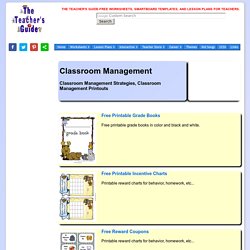
“Bounce the Detention!” – demanding silent work with a lighthearted touch. This is a simple strategy that I have used for many years when students need to work silently for a period of time.
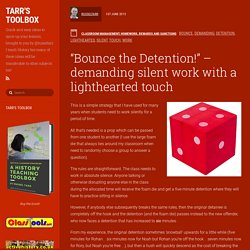
All that’s needed is a prop which can be passed from one student to another (I use the large foam die that always lies around my classroom when need to randomly choose a group to answer a question). The rules are straightforward. The class needs to work in absolute silence. Anyone talking or otherwise disrupting anyone else in the class during the allocated time will receive the foam die and get a five-minute detention where they will have to practice sitting in silence.
However, if anybody else subsequently breaks the same rules, then the original detainee is completely off the hook and the detention (and the foam die) passes instead to the new offender, who now faces a detention that has increased to six minutes. Like any disciplinary strategy it is of course crucial that the rules are made absolutely clear from the outset, and applied firmly but fairly. Create a seating chart. Evernote como agenda escolar electrónica: recordatorios en notas. El trabajo del profesor está marcado por un calendario concreto y se trabaja contra reloj.

La demanda de tiempo obliga a organizar una apretada agenda escolar y un horario de clases con un sistema más o menos sofisticado. Una herramienta “Evernote” que se define con la frase “Recuérdalo todo” hacía suponer que contenía un calendario y un sistema de notificaciones para usarse como agenda electrónica. Para la sorpresa de muchos, éste no era el caso hasta hace unos días. Certificate Magic - Free certificate generator. Organisation de la classe : structure. Les groupes sont organisés par besoin, par projet, par intérêt, par niveau, par méthode, par discipline etc .
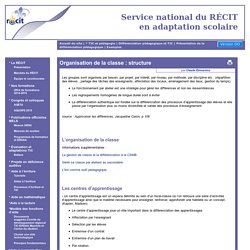
(répartition des élèves , partage des tâches des enseignants, affectation des locaux, aménagement des lieux, gestion du temps) Le fonctionnement par atelier est une stratégie pour gérer les différences et non les ressemblances Les regroupements homogènes de longue durée sont à éviter La différenciation authentique est fondée sur la différenciation des processus d’apprentissage des élèves et elle passe par l’organisation plus ou moins diversifiée et variée des processus d’enseignement source : Apprivoiser les différences, Jacqueline Caron, p 106. Top Tips for Successful Classroom Discipline and Management. 5.
Be Fair and Consistent Students have a distinct sense of what is and what is not fair. Teachers must treat all students with respect and treat all students equitably. One of the worst things that can happen in the classroom is the student(s)'s perception that the rules are not enforced fairly or consistently. Le générateur de certificats BRAVO. Gestion de classe. Gestion de classe. CLASSROOM RULES worksheet. 13 trucs de gestion de classe qui instaurent le respect.